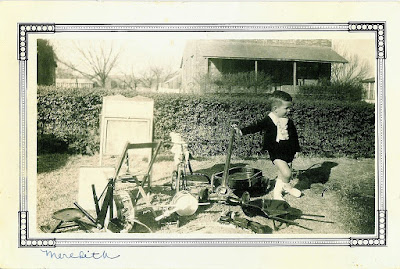The History of Thurber in 12 Photographs: Playtime in Thurber
by: Mary Adams
Thurber, Texas, a company owned coal mining and brick making town, provided jobs for workers from all over the world. We spend a lot of time talking about the town, the Company, and the people who moved to Thurber because without these three entities there would be no history to discuss. Thurber was more than this; it was also a family town. With workers came families and children. The Company provided schools for these children but we all know there is more to life than work and school, we all need some playtime. The adults of Thurber had their playtime in a variety of areas including the saloons, fraternal groups, baseball and heated games of bocci ball, but what about the kids? Children and games go hand in hand. The opportunity to play allows children to develop skills needed as adults, such as cooperation, communication, and problem-solving skills. So what did Thurber children do for fun?
Baseball was a very important pastime for adults and kids alike. Thurber had many different baseball teams throughout its history. The Company even sponsored semi-pro teams who traveled to area towns to compete. This month's picture shows a group of boys with their bats and gloves dressed in their Thurber Tiger uniforms indicating that there were also teams for young boys who enjoyed the sport.
Organized sports were not the only forms of fun that entertained the children of Thurber. Yoyos and tops were great ways to pass time. Girls often played games like hopscotch, jacks or jump rope. However, they also played marbles with the boys and according to Mary Franks, a former Thurber resident, “the girls were just as good as the boys.” Some of these activities could be quite cutthroat. Children would modify store-bought toys to give them a competitive edge. For instance, driving nails into the center of tops would make them spin faster. Sharpening the nail also increased the potential of splitting their friend's top. Many of these games were played “for keeps” allowing the victor to take away their opponents game pieces.
Kids who did not have money for store-bought toys took what might be considered trash and turn it into a toy that provided hours of fun. For example, a tin can could begin a game kick the can or be made into stilts with the addition of some twine. If a ball couldn't be found for stickball inventive children would take old hosiery and layer it around something heavy in the center to create one. There were also games like hide and seek or wolf over the river (red rover) that large groups could play. Kids interested in showing their strength, speed, and dexterity would often start races or games of leapfrog.
Various forms of play, whether organized sports or individual pursuits helped the children of Thurber become active adults as they developed a sense of their own abilities while creating close bonds with their friends and future coworkers.
 |
| Thurber Tigers Baseball Team, ca. 1908-1910 Cooney Collection |
Baseball was a very important pastime for adults and kids alike. Thurber had many different baseball teams throughout its history. The Company even sponsored semi-pro teams who traveled to area towns to compete. This month's picture shows a group of boys with their bats and gloves dressed in their Thurber Tiger uniforms indicating that there were also teams for young boys who enjoyed the sport.
 |
| Children playing in Thurber street Courtesy of University of Texas at Arlington Special Collections |
Organized sports were not the only forms of fun that entertained the children of Thurber. Yoyos and tops were great ways to pass time. Girls often played games like hopscotch, jacks or jump rope. However, they also played marbles with the boys and according to Mary Franks, a former Thurber resident, “the girls were just as good as the boys.” Some of these activities could be quite cutthroat. Children would modify store-bought toys to give them a competitive edge. For instance, driving nails into the center of tops would make them spin faster. Sharpening the nail also increased the potential of splitting their friend's top. Many of these games were played “for keeps” allowing the victor to take away their opponents game pieces.
Kids who did not have money for store-bought toys took what might be considered trash and turn it into a toy that provided hours of fun. For example, a tin can could begin a game kick the can or be made into stilts with the addition of some twine. If a ball couldn't be found for stickball inventive children would take old hosiery and layer it around something heavy in the center to create one. There were also games like hide and seek or wolf over the river (red rover) that large groups could play. Kids interested in showing their strength, speed, and dexterity would often start races or games of leapfrog.
 |
| Thurber child, Meredith Sides posing with his collection of toys O. M. Sides Collection |

